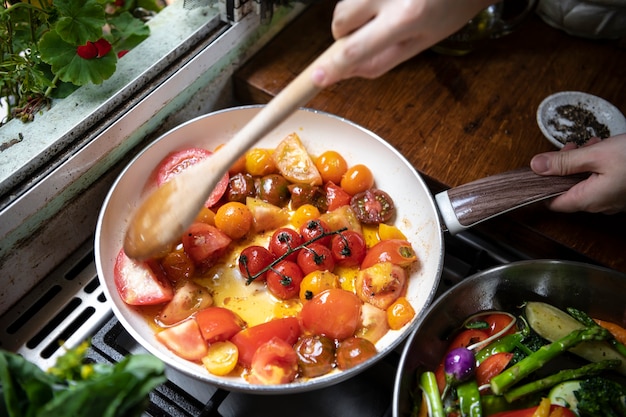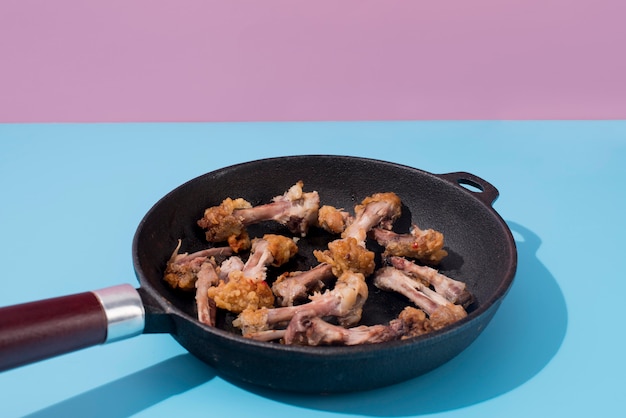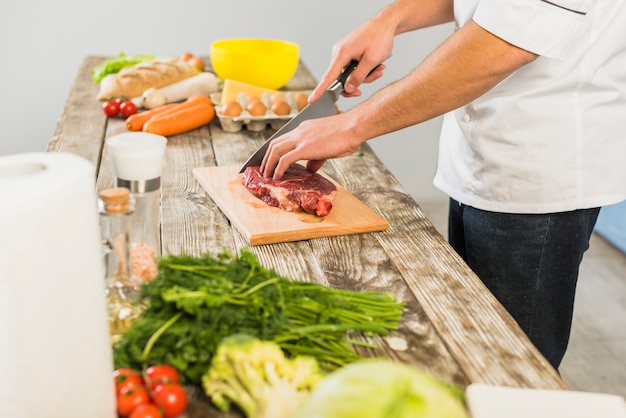Right, let's talk cow tongue. I know what you're thinking: "Cow tongue? Seriously?" But trust me, this often overlooked cut of meat can be absolutely delicious, and I'm here to convince you to give it a go. It's been a staple in many cultures for centuries, and I'm going to show you just how versatile and flavourful it can be.
This article is your comprehensive guide to all things cow tongue. We'll delve into its history, explore its unique qualities, master different cooking methods, and dive into a world of delicious recipes. I'll share my personal experiences, tips and tricks, and even some unconventional ways to enjoy this fascinating cut of meat.
So, if you're feeling adventurous and ready to expand your culinary horizons, grab a cuppa and settle in. Let's get cooking!
(Part 1) The Curious Case of Cow Tongue

A culinary journey Through Time
Cow tongue, while not as commonly found in mainstream kitchens, has a rich and fascinating history. It's been a traditional ingredient in many cultures for centuries, from Mexico to the Philippines to Eastern Europe. You might be surprised to learn how ingrained it is in these culinary traditions, often used in hearty stews, spicy braises, and even the occasional tongue sandwich.
Why Should You Care About Cow Tongue?
Now, you might be wondering: Why bother with cow tongue? Well, it's a surprisingly versatile cut, offering a unique flavour and texture that's unlike any other meat. It's also a great source of protein, iron, and other essential nutrients, making it a nutritious addition to your diet.
But beyond its practical benefits, cow tongue offers a truly unique culinary experience. It's a conversation starter, a bit of a culinary adventure. Serving up a tongue dish is guaranteed to spark curiosity, maybe even a little apprehension, which you can then easily dispel with a delicious mouthful.
(Part 2) Selecting and Preparing Your Cow Tongue

Choosing the Right Tongue
The first step is selecting a good tongue. Now, I'm no butcher, but I've learned a few things over the years. Look for a tongue that's firm and plump, with a nice, even colour. A good tongue will have a slightly pinkish-red hue, free from any discolouration. Avoid any that have a strange odour or look overly pale.
Cleaning the Tongue: A Step-by-Step Guide
Once you've got your tongue, it's time to prepare it for cooking. This involves cleaning it, which might sound daunting, but it's actually quite straightforward.
1. Rinse Thoroughly: Start by rinsing the tongue under cold running water to remove any loose debris.
2. Remove Excess Fat: Use a sharp knife to trim any excess fat from the tongue. You can either discard this or save it for later use in making a flavorful gravy or sauce.
3. Scrape the Membranes: The tongue is covered with a thin membrane that needs to be removed. You can do this by using a sharp knife to scrape it off. This might seem a bit daunting, but it's a crucial step for achieving a tender and flavorful result.
4. Final Rinse: Rinse the tongue again under cold water to remove any remaining debris.
(Part 3) cooking techniques for Cow Tongue

Cow tongue is a versatile cut that can be cooked in various ways, each yielding a unique texture and flavour. Let's delve into the most popular methods:
1. Boiling: A Classic Approach
Boiling is the most common method for cooking cow tongue. It's a simple and straightforward technique that allows the meat to soften and become tender. Imagine a long, relaxing bath for your tongue.
The Process: Place the tongue in a large pot of water, ensuring it's completely submerged. Bring the water to a boil, then reduce heat and simmer for 2-4 hours, or until the tongue is tender enough to be easily pierced with a fork.
Adding Flavour: Don't forget to add flavour to your boiling water. You can use onions, carrots, celery, bay leaves, peppercorns, and other herbs and spices to create a flavorful broth.
2. Braising: A Rich and Aromatic Experience
Braising takes boiling to the next level, offering a more flavorful and richer dish. This slow cooking method involves searing the tongue first, locking in those delicious juices, and then simmering it in a flavorful broth. Think of braising as giving your tongue a delicious massage.
The Process:
Searing: Heat some oil in a large pot or dutch oven over medium-high heat. Sear the tongue on all sides, achieving a nice golden brown crust.
Simmering: Add your flavorful broth to the pot, ensuring the tongue is fully submerged. Bring the broth to a simmer, then cover the pot and cook for 2-4 hours, or until the tongue is incredibly tender.
3. Roasting: A Skillful Technique for the Adventurous Cook
Roasting cow tongue can be a bit more challenging, requiring a little more skill and experience. However, it's a great way to bring out the tongue's natural flavour and create a stunning presentation. Think of roasting as giving your tongue a sun tan.
The Process:
Preparation: Preheat your oven to 350°F (175°C). Season the tongue generously with salt, pepper, and any other desired spices. Place the tongue on a roasting rack set over a baking sheet.
Roasting: Roast for 2-3 hours, or until the tongue is tender and the internal temperature reaches 145°F (63°C).
Resting: Once cooked, remove the tongue from the oven and let it rest for 10-15 minutes before slicing and serving.
(Part 4) Classic Cow Tongue Recipes
Now, let's get into the good stuff – the recipes. These classic dishes showcase the versatility and deliciousness of cow tongue.
1. Lengua en Salsa Verde: A Mexican Masterpiece
This Mexican classic is a true delight. Imagine tender tongue simmered in a vibrant, tangy green sauce, often made with tomatillos, jalapeno peppers, and cilantro. It's a flavour explosion that will tantalize your taste buds.
Key Ingredients:
Cow tongue, boiled and sliced
Tomatillos, roasted and blended into a sauce
Jalapeno peppers, finely chopped
Cilantro, finely chopped
Onions, chopped
Garlic, minced
Lime juice
Salt and pepper
Instructions:
In a large pot or Dutch oven, simmer the tongue in the salsa verde for about 30 minutes, or until heated through.
Serve hot, garnished with fresh cilantro and a squeeze of lime.
2. Filipino Lengua Estofado: A Comforting Stew
This Filipino stew is packed with flavour and aroma. The tongue is braised in a rich broth seasoned with soy sauce, vinegar, garlic, onions, and a touch of sweetness. It's a comforting and satisfying dish that's perfect for a family meal.
Key Ingredients:
Cow tongue, boiled and sliced
Soy sauce
Vinegar
Garlic, minced
Onions, chopped
Bay leaves
Black peppercorns
Brown sugar
Instructions:
In a large pot or Dutch oven, saute the garlic and onions until fragrant.
Add the tongue, soy sauce, vinegar, bay leaves, black peppercorns, and brown sugar.
Cover the pot and simmer for 1-2 hours, or until the tongue is incredibly tender.
Serve hot, over rice or noodles.
3. Hungarian Beef Tongue with Horseradish: An Elegant Delight
Here's a recipe that's both elegant and hearty. The tongue is simmered in a flavorful broth, then served with a dollop of creamy horseradish. It's a dish that will impress your guests.
Key Ingredients:
Cow tongue, boiled and sliced
Carrots, chopped
Celery, chopped
Onions, chopped
Bay leaves
Black peppercorns
Allspice berries
Horseradish cream
Instructions:
In a large pot or Dutch oven, simmer the tongue in beef broth with the carrots, celery, onions, bay leaves, black peppercorns, and allspice berries for 1-2 hours.
Serve hot, topped with horseradish cream.
(Part 5) Tips and Tricks for Success
Now, let's talk about some tips and tricks for ensuring your cow tongue dishes are a hit.
1. Patience is Key
Cooking cow tongue requires patience. It takes time for the meat to soften and become tender. Don't rush the process. Allow the meat to cook slowly, allowing the flavours to meld.
2. Master the Art of Searing
For braising and roasting, searing the tongue is a crucial step. It helps to lock in the juices and develop a rich flavour. Make sure to heat the oil properly before searing, and sear the tongue on all sides to achieve a beautiful golden brown crust.
3. Don't Fear the Fat
Don't discard the fat that renders off the tongue during cooking. It's packed with flavour and can be used to make a delicious gravy or sauce. Simply skim off the fat, let it cool, and then strain it to remove any solids. You can then use it to enhance the flavour of your dish.
(Part 6) Serving Up Your Cow Tongue Masterpiece
1. The Art of Presentation
Let's be honest, cow tongue doesn't have the most appealing appearance. But that doesn't mean you can't serve it up beautifully.
Slice Thinly: Slice the cooked tongue thinly to make it more visually appealing.
Arrange on a Platter: Arrange the slices on a platter, perhaps with a bed of greens or a garnish of fresh herbs.
Use a Sauce or Gravy: A rich sauce or gravy can add a touch of elegance and enhance the overall flavour.
2. Accompaniments
A well-chosen accompaniment can elevate your cow tongue dish to another level.
Roasted Vegetables: Roasted vegetables like carrots, potatoes, and onions provide a satisfying crunch and complement the rich flavour of the tongue.
Creamy mashed potatoes: creamy mashed potatoes provide a comforting and indulgent pairing.
Vibrant Salads: A vibrant salad with fresh greens, colorful vegetables, and a tangy dressing can add a refreshing contrast to the richness of the tongue.
(Part 7) Exploring the Unconventional
1. Cow Tongue Salads: A Surprising Delight
Yes, you heard that right. Cow tongue can be a surprisingly delicious addition to salads.
Thinly Sliced: Slice the cooked tongue thinly, adding a unique texture and flavour to your salads.
Tangy Dressing: A tangy vinaigrette or a creamy dressing can balance the richness of the tongue and bring out the flavors of the other ingredients.
Fresh Greens and Vegetables: Combine the sliced tongue with your favorite greens, like spinach, arugula, or romaine lettuce, and add colourful vegetables like bell peppers, tomatoes, cucumbers, and onions.
Cheese: A sprinkle of crumbled feta, goat cheese, or parmesan cheese adds a salty and creamy touch.
2. Cow Tongue Sandwiches: A Hearty and Unique Lunch
Who needs roast beef when you can have tongue? A thinly sliced tongue sandwich with a bit of horseradish and mustard is a hearty and satisfying lunch.
Bread: Choose a sturdy bread, like sourdough or rye, that can hold up to the juicy filling.
Spreads: A dollop of horseradish cream, mustard, or even a spicy mayo can add a flavorful punch.
Other Ingredients: You can also add other toppings, such as thinly sliced onions, pickles, or even a slice of tomato.
3. Cow Tongue Tacos: An Adventurous Twist on a Classic
Feeling adventurous? Try making cow tongue tacos. It's a unique and delicious twist on a classic.
Preparation: Cook the tongue according to your preferred method, and then shred or slice it thinly.
Taco Shells: Use your favorite taco shells, whether soft corn tortillas or crispy flour tortillas.
Toppings: Add your favorite taco toppings, like salsa, chopped onions, cilantro, shredded cheese, and a squeeze of lime.
(Part 8) FAQs
Let's answer some common questions about cow tongue:
1. How long does it take to cook cow tongue?
The cooking time varies depending on the method and the size of the tongue.
Boiling: Boil for 2-4 hours, or until tender.
Braising: Braise for 2-4 hours, or until incredibly tender.
Roasting: Roast for 2-3 hours, or until tender and the internal temperature reaches 145°F (63°C).
2. What does cow tongue taste like?
Cow tongue has a mild, slightly sweet flavour. It's rich and meaty, but not as strong as beef. It's often described as having a similar texture to brisket or chuck roast.
3. Is cow tongue chewy?
When cooked properly, cow tongue should be tender and melt-in-your-mouth. If it's chewy, it might not have been cooked long enough. Ensure you cook it for the appropriate time, based on your chosen method.
4. Where can I find cow tongue?
You can find cow tongue at some butchers, specialty markets, or online. If you can't find it locally, ask your butcher if they can order it for you.
5. What are some other ways to cook cow tongue?
Besides boiling, braising, and roasting, you can also explore other methods:
Smoking: Smoking cow tongue imparts a smoky flavour and tenderizes the meat.
Grilling: Grilling can create a delicious char and enhance the flavour of the tongue.
Frying: You can pan-fry or deep-fry cow tongue, creating a crispy exterior and tender interior.
(Part 9) Embracing the Unfamiliar
So, there you have it – your ultimate guide to cooking cow tongue. It's a journey of discovery, a chance to challenge your culinary boundaries and explore a world of flavour. Don't be afraid to step outside your comfort zone and try something new. You might just surprise yourself!
Everyone is watching

Perfect Rice Every Time: The Ultimate Guide to Cooking Rice
Cooking TipsAs a self-proclaimed foodie, I've always been a bit obsessed with rice. It's the foundation of countless cuisi...

Prime Rib Roast Cooking Time Chart: Per Pound Guide
Cooking TipsPrime rib roast. Just the name conjures images of lavish dinners, crackling fires, and hearty laughter. It’s ...

The Ultimate Guide to Cooking Asparagus: Tips, Techniques, and Recipes
Cooking TipsAsparagus. The mere mention of this spring delicacy conjures up images of vibrant green spears, crisp and burs...

Ultimate Guide to Cooking the Perfect Thanksgiving Turkey
Cooking TipsThanksgiving. Just the word conjures up images of overflowing tables laden with delicious food, the scent of r...

How Long to Bake Potatoes in the Oven (Perfect Every Time)
Cooking TipsBaked potatoes are a staple in my kitchen. They're incredibly versatile, delicious, and surprisingly easy to m...
